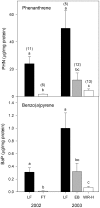Recurrent die-offs of adult coho salmon returning to spawn in Puget Sound lowland urban streams
- PMID: 22194802
- PMCID: PMC3237429
- DOI: 10.1371/journal.pone.0028013
Recurrent die-offs of adult coho salmon returning to spawn in Puget Sound lowland urban streams
Abstract
Several Seattle-area streams in Puget Sound were the focus of habitat restoration projects in the 1990s. Post-project effectiveness monitoring surveys revealed anomalous behaviors among adult coho salmon returning to spawn in restored reaches. These included erratic surface swimming, gaping, fin splaying, and loss of orientation and equilibrium. Affected fish died within hours, and female carcasses generally showed high rates (>90%) of egg retention. Beginning in the fall of 2002, systematic spawner surveys were conducted to 1) assess the severity of the adult die-offs, 2) compare spawner mortality in urban vs. non-urban streams, and 3) identify water quality and spawner condition factors that might be associated with the recurrent fish kills. The forensic investigation focused on conventional water quality parameters (e.g., dissolved oxygen, temperature, ammonia), fish condition, pathogen exposure and disease status, and exposures to metals, polycyclic aromatic hydrocarbons, and current use pesticides. Daily surveys of a representative urban stream (Longfellow Creek) from 2002-2009 revealed premature spawner mortality rates that ranged from 60-100% of each fall run. The comparable rate in a non-urban stream was <1% (Fortson Creek, surveyed in 2002). Conventional water quality, pesticide exposure, disease, and spawner condition showed no relationship to the syndrome. Coho salmon did show evidence of exposure to metals and petroleum hydrocarbons, both of which commonly originate from motor vehicles in urban landscapes. The weight of evidence suggests that freshwater-transitional coho are particularly vulnerable to an as-yet unidentified toxic contaminant (or contaminant mixture) in urban runoff. Stormwater may therefore place important constraints on efforts to conserve and recover coho populations in urban and urbanizing watersheds throughout the western United States.
Conflict of interest statement
Figures






References
-
- Gilhousen P. Prespawning mortalities of sockeye salmon in the Fraser River system and possible causal factors, Bulletin XXVI. Vancouver BC: International Pacific Salmon Fisheries Commission; 1990.
-
- Cooke SJ, Hinch SG, Farrell AP, Lapointe MF, Jones SRM, et al. Abnormal migration timing and high en route mortality of sockeye salmon in the Fraser River, British Columbia. Fisheries. 2004;29:22–33.
-
- Crossin GT, Hinch SG, Cooke SJ, Welch DW, Patterson DA, et al. Exposure to high temperature influences the behaviour, physiology, and survival of sockeye salmon during spawning migration. Can Jour Zool. 2008;86:127–140.
-
- Quinn TP. The behavior and ecology of Pacific salmon and trout. 2005. American Fisheries Society, Bethesda, Maryland and University of Washington Press, Seattle and London.
-
- Quinn TP, Eggers DM, Clark JH, Rich HB. Density, climate, and the processes of prespawning mortality and egg retention in Pacific salmon (Oncorhynchus spp.). Canadian Jour Fish Aquat Sci. 2007;64:574–582.
Publication types
MeSH terms
Substances
LinkOut - more resources
Full Text Sources
Medical

